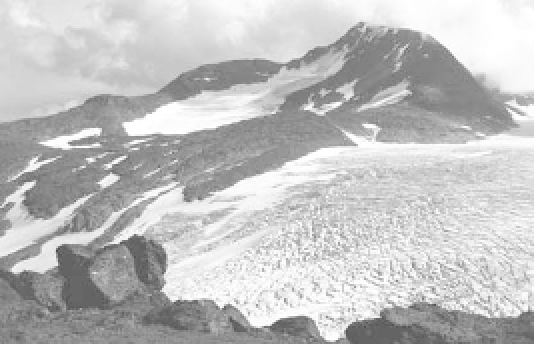Geology Reference
In-Depth Information
Plate 10.2
Cirque glacier, Skoltbreen, Okstindan,
northern Norway. Austre Okstindbreen, a crevassed
glacier, is seen in the foreground.
(
Photograph by Mike Hambrey
)
(Plate 10.2).
Valley glaciers
sit in rock valleys and are
overlooked by rock cliffs (Plate 10.3; see also Plate 10.4).
They commonly begin as a cirque glacier or an ice sheet.
Tributary valley glaciers may join large valley glaciers to
create a valley-glacier network.
Piedmont glaciers
form
where valley glaciers leave mountains and spread on to a
flat land as large lobes of spreading ice, an example being
the Malaspina Glacier, Alaska.
Tidewater glaciers
are
valley glaciers that flow into the sea, where they pro-
duce many small icebergs that may pose a danger to
shipping.
Plate 10.3
Valley glacier - the Mer de Glace - in the
French Alps.
(
Photograph by Mike Hambrey
)
contributions may come from rainfall freezing on the ice
surface, the condensation and freezing of saturated air,
the refreezing of meltwater and slush, and avalanching
from valley sides above the glacier. In temperate regions,
ablation results mainly from melting, but it is also accom-
plished by evaporation, sublimation, wind and stream
erosion, and calving into lakes and the sea. In Antarctica,
calving is nearly the sole mechanism of ice loss.
The changes in the form of a glacier during an equilib-
rium balance year are shown in Figure 10.3. The upper
part of the glacier is a snow-covered accumulation zone
and the lower part is an ablation zone. The
firn line
is
the dividing line between the accumulation and ablation
zones. For a glacier that is in equilibrium, the net gains of
water in the accumulation zone will be matched by the
Glacier mass balance
A
glacier mass balance
is an account of the inputs and
outputs of water occurring in a glacier over a speci-
fied time, often a year or more. A glacier balance year
is the time between two consecutive summer surfaces,
where a summer surface is the date when the glacier mass
is lowest. Mass balance terms vary with time and may
be defined seasonally. The winter season begins when
the rate of ice gain (
accumulation
) exceeds the rate of
ice loss (
ablation
), and the summer season begins when
the ablation rate exceeds the accumulation rate. By these
definitions, the glacier balance year begins and ends in
late summer or autumn for most temperate and subpo-
lar regions. Most accumulation is caused by snowfall, but


